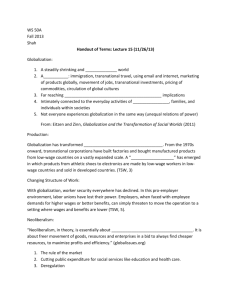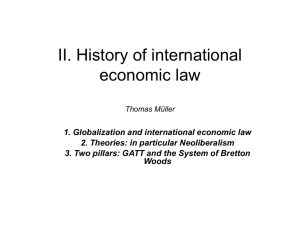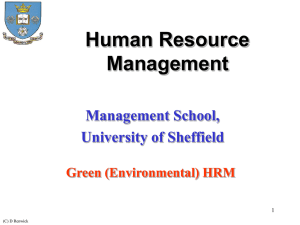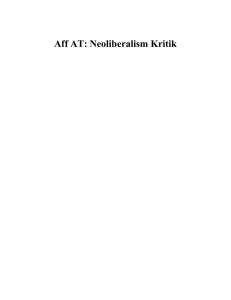KGa171-L7.2-final
advertisement
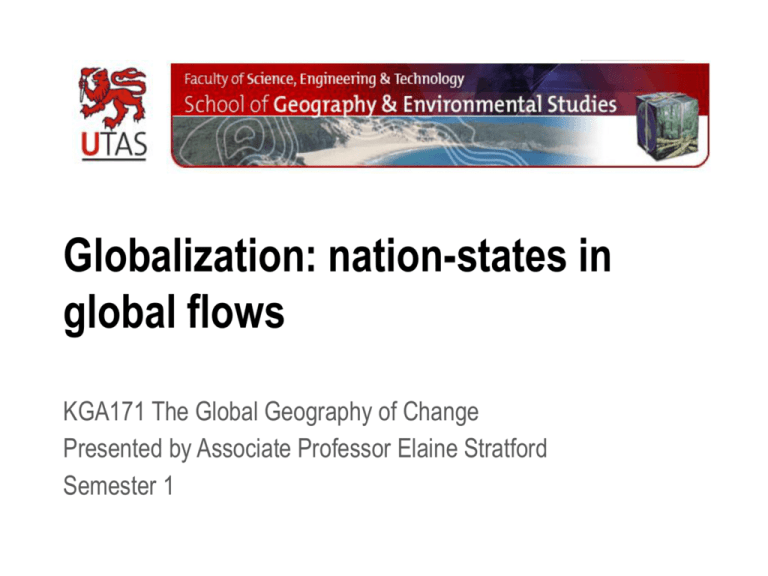
Globalization: nation-states in global flows KGA171 The Global Geography of Change Presented by Associate Professor Elaine Stratford Semester 1 Globalization – portmanteau and contested term Protest in Hong-Kong against WTO in December 2005 Part 1 LOOKING FORWARD, LOOKING BACK Revising Module 7 Lecture 1 1. Define the following and exemplify their meanings: a. b. c. d. e. f. state sovereign territoriality nation regnum dominium 2. What is the Peace of Westphalia and why is it significant in relation to statehood? 3. What is meant by the assertion that a nationstate is an ideal alignment between shared culture and territory? 4. What are the key spatial characteristics of decolonization after 1945 and what geopolitical trends do they represent? 5. What might Kurdistan, Sri Lanka and parts of Spain and France have in common? Man thinking Learning Objectives Module 7 Lecture 2 KGA171 Be able to: • describe and explain some of the key characteristics of globalization, liberalism and neoliberalism • convey the importance of transnationalism as a part of globalization • argue the merits of the case both for and against the idea that globalization is merely a disguise for westernization • demonstrate knowledge of geographical concepts, earth and social systems and spatial patterns of change • create and interpret basic maps, graphs and field data • identify and analyse different viewpoints to contribute to debates about global development • communicate in reflective and academic writing, referencing literature when needed Textbook Reading Bergman and Renwick (2008) read pp.246-255, 521-29 and scan Chapter 13 Extension reading: Starr, Amory and Adams, Jason (2003) Anti-globalization: The Global Fight for Local Autonomy, New Political Science 25(1) pp.19 - 42. Critical reading 1.What is the author’s purpose? 2.What key questions or problems does the author raise? 3.What information, data and evidence does the author present? 4.What key concepts does the author use to organize this information, this evidence? 5.What key conclusions is the author coming to? Are those conclusions justified? 6.What are the author’s primary assumptions? 7.What viewpoints is the author writing from? 8.What are the implications of the author’s reasoning? [from Foundation for Critical Thinking] Man reading a book Part 2 LIBERALISM AND NEOLIBERALISM Liberalism Jeremy Bentham, founding figure of liberalism as a political movement, painted by Henry William Pickersgill, date unknown. Also John Stuart Mill and Harriet Taylor Mill Property rights John Locke, by Herman Verelst, date unknown Property – key to prosperity Blenheim Palace, from Jones's Views of the Seats of Noblemen and Gentlemen (1829) Social contracts Immanuel Kant Steel engraving by J. L. Raab, 1791 after a painting by Döbler Alternative perspectives on property Pierre Joseph Proudhon Gustave Courbet, 1865 Neoliberalism Margaret Thatcher, ex Prime Minister of Great Britain and a key advocate of neoliberal policy Bretton Woods, New Hampshire A multi-national agreement which was created after World War II to ensure international monetary management and determine how commercial and financial relations would be determined among industrialized states was signed at this location in 1944. The International Monetary Fund and World Bank were established at the same time. Resistance to neoliberal excesses Graffiti protesting the poll tax, Huddersfield, London Part 3 A TRANSNATIONAL ORDER? Economic globalization Diffusion of McDonalds Restaurants around the globe. Note that subnational subtleties are not shown well in the map. For instance Tasmania did not have a McDonalds in the period pictured. Lloyds Bank Subscription Room As drawn by Thomas Rowlandson and Augustus Pugin for Thomas Rowlandson's Microcosm of London (1808-11) MNCs and TNCs Pattern of colours formed by oil on water UNCTAD (2008) World Investment Report: Transnational Corporations and the Infrastructure Challenge, UNCTAD, New York Foreign direct investment “investment in enterprises that are actually operated by a foreign owner” (Bergman and Renwick 2008, p.522) Regional International Associations Nation-State Bergman and Renwick (2008) p.557 Uneven geographies of foreign direct investment Four Asian Tigers-South Korea, Taiwan, Hong Kong, Singapore New Asian Tigers-Philippines, Indonesia, Malaysia, Thailand China Is the World Trade Organization problematic? YouTube video of 4.38 minutes. Part 4 A GLOBAL CULTURE? Cultural imperialism Photograph of an 1888 portrait of the Emperor Meiji by Italian painter Eduardo Chiossone (1833—1898) Globalization and homogenization Knox and Marsden (2004) p.198 Globalization and hybridity? Globalization and resistance "Radical reform movements aim to subordinate corporations to established frameworks of democracy" (Starr and Adams 2003, p.20). Alternative futures There is an often unspoken perception that modernization will not deliver and that leads to “creative articulation of alternative development paths which center indigenous knowledge, equitable attention to the perspectives of men and women, and the decommodification of nature” (Starr and Adams 2003, p.37).




